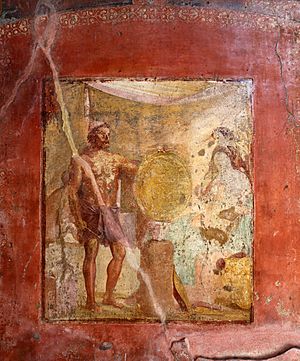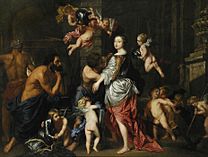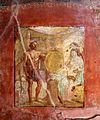Vulcan (mythology) facts for kids
Quick facts for kids Vulcan |
|
|---|---|
| God of fire, metalworking, and the forge | |
| Member of the Dii Consentes | |

|
|
| Abode | under the island of Vulcano |
| Symbol | Blacksmith's hammer |
| Temples | Vulcanal |
| Festivals | the Vulcanalia |
| Personal information | |
| Consort | Venus |
| Parents | Jupiter and Juno |
| Siblings | Mars, Minerva, Hercules, Bellona, Apollo, Diana, Bacchus, etc. |
| Greek equivalent | Hephaestus |
| Etruscan equivalent | Sethlans |
Vulcan (also called Volcanus) was the Roman god of fire. He was known for controlling the fire of volcanoes, deserts, and the flames used in metalworking. He was also the god of the forge, where metals are shaped. You often see him pictured with a blacksmith's hammer.
The Romans held a special yearly festival for him called the Vulcanalia on August 23. In Greek mythology, Vulcan is known as Hephaestus. In Etruscan religion, he was called Sethlans. Vulcan is one of the oldest gods in Roman religion. Ancient writers say that King Titus Tatius built altars to him a very long time ago.
Contents
Understanding Vulcan's Name
The exact origin of Vulcan's name is not fully clear. Roman traditions believed it was linked to Latin words about lightning and flames. This makes sense, as Vulcan is the god of fire! Some experts think his name might come from an older god called Velchanos from the island of Crete.
How Romans Worshipped Vulcan
Vulcan's oldest shrine in Rome was called the Vulcanal. It was located at the bottom of the Capitoline Hill in the Roman Forum. People believed it was built by King Titus Tatius around the 8th century BC. The Romans thought that a temple for Vulcan should be outside the city walls. This was because fire could be dangerous.
The Romans saw Vulcan as similar to the Greek god Hephaestus. Both were skilled smith-gods who used fire to create things from metal. However, Vulcan was also strongly linked to the destructive power of fire. His followers hoped he would protect them from harmful fires.

| Vulcanalia | |
|---|---|
| Observed by | Ancient Rome |
| Type | Roman, Historical |
| Celebrations | Bonfires in honour of Vulcan |
| Observances | Sacrifice of fish |
| Date | August 23rd |
The Vulcanalia Festival
The festival for Vulcan, the Vulcanalia, was held every year on August 23. This was a time when the summer heat was very strong, and crops and storage buildings were at high risk of burning. During the festival, people lit bonfires to honor the god. They would throw live fish or small animals into the fires as a sacrifice. This was meant to ask Vulcan to protect humans from fire.
Another tradition on this day was to start work by the light of a candle. This was probably to encourage the god to use fire in a helpful way.
Important Events and Vulcan
After the Great Fire of Rome in AD 64, people prayed to Vulcan to calm the fires. Emperor Domitian (who ruled from 81–96 AD) even built a new altar to Vulcan. He also added red bull-calf and red boar to the sacrifices made during the Vulcanalia.
Vulcan's Role and Family
Vulcan was seen as a god who controlled both the destructive and helpful sides of fire. He was also the patron god of jobs related to ovens, like cooks, bakers, and confectioners.
Vulcan's Children
According to ancient stories, Vulcan had several sons. These included Philammon, Cecrops, Erichthonius, Corynetes, Cercyon, Philottus, and Spinther.
Myths of Vulcan (Hephaestus)
Because the Romans connected Vulcan with the Greek god Hephaestus, many Greek myths became part of Vulcan's story. He was believed to be the maker of amazing art, weapons, and jewelry for gods and heroes. This included the powerful lightning bolts of Jupiter.
Born on Mount Olympus
Vulcan was the son of Jupiter, the king of the gods, and Juno, the queen. He should have been very handsome, but when he was born, he was small, ugly, and cried loudly. Juno was so upset that she threw him off the top of Mount Olympus.
Vulcan fell for a whole day and night, finally landing in the sea. Sadly, one of his legs broke when he hit the water and never healed properly. He sank to the bottom of the ocean, where a kind sea-nymph named Thetis found him. She took him to her underwater cave and raised him as her own son.
Discovering Fire and Metalworking
Vulcan had a happy childhood playing with dolphins and pearls. Later, he found the remains of a fisherman's fire on the beach. He was amazed by a glowing, red-hot coal.
Vulcan carefully put the coal in a clamshell and took it back to his cave. He made a fire with it. For hours, he watched the flames. The next day, he learned that if he made the fire hotter with bellows, some stones would "sweat" iron, silver, or gold. On the third day, he hammered the cooled metal into shapes. He made bracelets, chains, swords, and shields. He even made pearl-handled knives for his foster mother and a silver chariot for himself. He also created golden slave-girls to help him.

Return to Olympus and Marriage
One day, Thetis went to a dinner party on Mount Olympus wearing a beautiful silver and sapphire necklace that Vulcan had made. Juno admired it and asked where she got it. Thetis became nervous, and Juno soon found out the truth: the baby she had rejected was now a very talented blacksmith.
Juno was furious and demanded Vulcan return home. He refused. However, he did send Juno a beautiful chair made of silver and gold. When Juno sat in it, hidden springs trapped her! The chair was a clever trick. Jupiter finally saved the day. He promised Vulcan that if he released Juno, he would give him Venus, the goddess of love and beauty, as his wife. Vulcan agreed and married Venus.
Vulcan later built his workshop under Mount Etna in Sicily. It was said that whenever Venus was unfaithful, Vulcan would get angry. He would beat the red-hot metal with such force that sparks and smoke would rise from the mountain, causing a volcanic eruption!
Other Creations
To punish humans for stealing fire, Jupiter ordered the gods to create a special gift. Vulcan's part was to mold the beautiful but foolish Pandora from clay and give her shape. He also made the thrones for the other gods on Mount Olympus.
Vulcan's Sanctuaries
The most important and oldest place of worship for Vulcan in Rome was the Volcanal. It was an open-air area at the foot of the Capitolium in the Roman Forum. It had a special area for the god and a fire that burned all the time.
According to Roman stories, the Volcanal was dedicated by Romulus, one of Rome's founders. He placed a bronze chariot there, a prize from a war. It's believed that the Volcanal was used as a place for cremation (burning bodies) in early Roman times.
Another temple for Vulcan was built before 215 BC in the Campus Martius. Games were held there in his honor during the Volcanalia festival.
Vulcan Outside Rome
In the ancient city of Ostia, the worship of Vulcan was very important. The main priest there was called the pontifex Vulcani et aedium sacrarum. He was in charge of all the sacred buildings in the town. This was the highest administrative job in Ostia.
Near Pozzuoli, there was an area called the agora of Hephaistos (or Forum Vulcani). This place had many sulfurous steam vents, similar to a volcano.
Vulcan in Modern Culture
- Vulcan is the patron god of the English city of Sheffield, known for its steel-making. His statue stands on top of Sheffield Town Hall.
- The Vulcan statue in Birmingham, Alabama is the largest cast iron statue in the world.
- The word volcano comes from the name of Vulcano, a volcanic island in Italy, which was named after the god Vulcan.
- A 12-foot-tall statue of Vulcan is the mascot for California University of Pennsylvania.
- The name "Vulcan" was suggested for one of Pluto's moons, but the International Astronomical Union chose other names instead.
- In the Star Trek series, the planet Vulcan is the home of Spock.
- Vulcan is a playable character in the video game Smite.
- The Avro Vulcan was a famous strategic bomber aircraft used by the Royal Air Force.
- Son of Vulcan is a superhero character in comics.
- Vulcan appears as a character in the TV series American Gods, where he is shown as the "god of guns."
Images for kids
-
Vulcan, wearing an exomis (tunic) and pilos (conical hat), sculpted by Bertel Thorvaldsen
-
A fresco of Vulcan-Hephaestus in Pompeii
-
The Forge of Vulcan by Diego Velázquez (1630)
See also
 In Spanish: Vulcano (mitología) para niños
In Spanish: Vulcano (mitología) para niños
- Kaveh the Blacksmith
- Kurdalægon
- Tlepsh
- Agni
- Atar
- Apam Napat
- Adur Burzen-Mihr
- Adur Gushnasp
- Vulcan Iron Works
- Vulcanization






